The Western Glass Manufacturing Company
by Tom Katonak
Reprinted from "Crown Jewels of the Wire", June 2001, page 28
Background:
For many years, I've been a collector of Denver glass insulators
with a concentration on those produced by the Western Glass Manufacturing
Company. I recall the first purple insulator I ever owned - a WGM toll that I
bought at the Colorado Springs flea market back in 1985. I could hardly bear to
pay the negotiated price of three dollars, but the piece was gorgeous and I had
to have it! Ever since that time, my interest in the Denver glass has continued
to grow. The purpose of this article is to focus on the Western Glass
Manufacturing Company and provide information for collectors and historians
alike on one of the early and most important producers of glass insulators in
the west. The interesting story of the turn-of-the-century insulator production,
and the men who made the glass document a fascinating chapter in the history of
the industry.
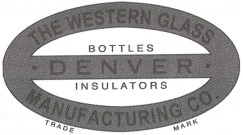
History:
Glass production started in Valverde, Colorado, a small village just
southwest of Denver, about 1887. Bottles became the mainstay of the operation
early on. The plan called for making window and plate glass as well, but
bottles were in such high demand that they never got into the sheet glass
business. In 1895, famous glassmaker, Robert Good Jr., arrived on scene to take
up the glass business he had learned from his father in England and New York.
Good rented the glass factory at Valverde and a year later, the R. Good
operation was in full production with both insulators and bottles. Soon
thereafter, William McLaughlin (of later California fame) came to work at the
plant.
Disaster struck in the summer of 1899 when fire caused by a ruptured
glass tank destroyed most of the plant. The plant was rebuilt late in '99, but
the high cost of investment money precipitated a reorganization of the company
as the "Western Flint Glass Company". WFG was prolific in its
production of insulators as well as bottles. These items were shipped and used
throughout the Rocky Mountain west.
In late 1900, the glass works was
reorganized for the third and final time, this time as the "Western Glass
Manufacturing Company". WGM was even more prolific than its forerunners, and a major factory expansion
phase took place in 1904, more than doubling the available floor space. This
expansion is well documented on the Sanborn maps of the period. Again, the major
product was bottles, but the fast-growing telephone business gave them a huge
market for insulators, particular the toll type, as well. WGM remained in
operation until about mid-1909 when it could no longer compete with the new
bottle forming machines used by most of the newer glass works. Declining profits
during the last several years led the owners to cease operations. Apparently,
the seven principals in the company were unwilling to make the necessary capital
investment to modernize the plant in order to update the equipment to industry
standards.
Notwithstanding their ever-increasing financial difficulties, WGM
produced a major portion of the food, beer, wine, medicine, soda and water
bottles used in Colorado and surrounding states. During its nine years of
operation, it also produced the lion's share of the telephone insulators for
both industry and long-line communications in the Rocky Mountain States. Even
today, one still finds an occasional purple WGM toll on an isolated pole or
perhaps half buried in the shifting sand in the back country of Colorado or New
Mexico.
A fascinating side-bar to the history of WGM is that very little
documentation and virtually no records from the business operations have been
found to date. In fact, only two company letters with the original WGM
letterhead have ever been found and these documents are located in the
collections of the Colorado Historical Society in Denver. Thanks to these
letters, we know the precise shape of the WGM logo, which I have redrawn for
this article. The letterheads on record are black and white, so I've used some
"authors license" in making the color red. Nevertheless, it is quite
remarkable that for a major operation that produced and shipped thousands of
tons of glass products all over the west for nearly a decade, so little
documentation of the details survives!
Glass Production:
The R. Good operation produced primarily aqua colored
insulators in CD's 106, 121, 134, and 162, although a brightly colored toll
turns up occasionally. When WFG assumed control in 1899, less care was taken in
the manufacturing process, and many insulators were produced that "wouldn't
have met the specification" if Robert Good were still in charge! Many WFG
"slumpers", "leaners", "steamers" and other crude
pieces have been found over the years and in some quite handsome colors.
When
WGM started up their operation, they used new molds and new glass mixtures for
their insulators. Their glass tended to be much more consistent in form and the
colors more uniform. In addition, they added the beehive (CDI45) to their style list due to the demand-pull from railroad
telegraphy. There are some that think the WGM insulators are "boring"
most being some shade of purple due to the addition of manganese dioxide.
However, there are many shades and hues of purple and other beautiful colors as
well: peach, ginger ale, silver, burgundy, gold and light green examples are
known - and photographs of many of these accompany this article.
Let's consider
the purple insulators for a moment: As it turns out, the lighter the shade of
purple glass, the more uncommon the piece. Deep purple WGM insulators are
perhaps two or three times more plentiful than the lighter purples.
Interestingly, the prices for the various shades of purple insulators do not
reflect the scarcity in that the deep or royal purples often command the higher
value. This, no doubt, reflects the "desirability factor" as opposed
to an evaluation based on scarcity alone. Another interesting aspect about the
purple glass is that there are two basic shades of the color: There is the more
common "red-purple" subgroup and the less frequently occurring
"lavender-purple" subgroup. This distinction becomes immediately
apparent when putting a random grouping of 50 tolls in a sunny window or
light-box and inspect the color variations in detail.
Looking at the variety of
the five WGM CD's, we note that the shapes of all the pieces are remarkably
different than the earlier Denver production. Particularly noteworthy is the CD
106 that has a "contemporary look" for that style of insulator. In
fact, most collectors agree that the WGM CD 106 is the prettiest of all the CD
106s. Also noteworthy is the fact that there are two major mold styles for the
CD 145 - "chunky" and "narrow". The narrow style is similar
to the postal beehive shape. No production records of the various insulator
types have ever been found, but based on the "findability" of WGMs
today, one would surmise that the tolls were the style of greatest production.
CD 145s are fairly common too, but they are far fewer in number than the tolls.
The third most common piece appears to be the CD 162 signal, followed by the CD
106 ponies. The least common of the suite is the CD 134s, making up perhaps only
one or two percent of the pieces found.
In an exciting recent development,
research currently being carried out by Mike Miller (of Denver) on the
production of both the embossed and un-embossed AM TEL & TEL toll insulators
is showing that there is a high probability that some of these may have been
manufactured by WGM circa 1909!
The Insulators:
The photos accompanying this article depict all five of the
WGM styles and attempt to demonstrate the range of color found in these
varieties as well.
Consider first the CD 106 ponies. As I mentioned earlier, the ponies are not
as abundant as some of the other CD's and their "swoop skirt" styling
is unique among the CD 106 variants. The ponies do not seem to occur in the deep
royal purple shades that the tolls and beehives are commonly found in and are
most usually located in a pleasing medium purple shade. Only occasionally will
you locate a royal purple or "black purple" specimen. The photo
grouping of ponies shows the range of rare colors that can be collected
including clear, burgundy, light green, straw and pink. The clear and light
green specimens are perhaps the most difficult colors to locate.
Let me
interrupt this discussion to make the point that there are a number of WGM
insulators that are suspect as to their color authenticity. In the 1970s, there
were several people in Colorado who experimented with heating purple WGM tolls
to high temperatures to come up with exotic colors. A large number of the
burgundy colored pieces in existence came about in this manner. Some of the pale
green insulators rarely found in the pony and toll shapes have also been
documented to be created through heating alterations. This is not to say
categorically that all burgundy and green WGMs are altered, but I certainly
regard every one that I encounter with suspicion!
Next, let's consider the CD
121 tolls. These were the "workhorse" of the insulator world during
the early 1900s and were used for all the inner-mountain west long-line phone
circuits and phone communications for the burgeoning western mining industry.
The vast majority of the CD 121s are to be found in purple glass. In fact,
they are in hot demand by today's collector because they come in such a great
range of purple colors and are relatively inexpensive. I've shown here the range
of purples for the tolls. The darkest are known as "black purple" and
are almost impossible to see through without using a very bright light source.
These black purple pieces are actually just very dense royal purple glass. To my
eye, the medium and light shades of purple are more attractive, but "to
each his own"! A second photo shows some of the more exotic shades that the
tolls may be found in. In fact, the tolls come in more colors than any of the
other WGM CDs. Here we see the range from greenish straw, through peach and
burgundy, to silver. Other colors to be found include salmon, ginger ale, pale
green, golden straw, and pink. Many of the exotic light colored examples (and
this applies to all the other WGM CDs as well) have been found mounted in
attics, under eves of buildings, or covered with paint on the outsides of
various buildings. In such cases, the UV activation of the Manganese-induced
purpling has been prevented.
Next in the order of CD numbers, we have the CD 134
signal insulator. Again, note that this shape is the least common of all the WGM
styles.
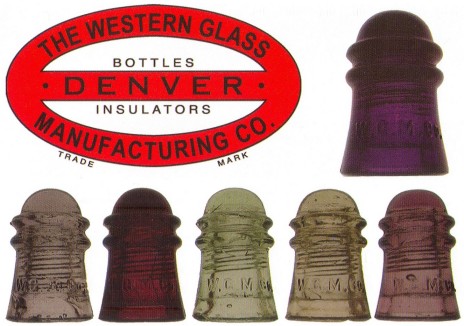
Hard to find CD 106 Colors:
clear, burgundy, light green, straw, pink.
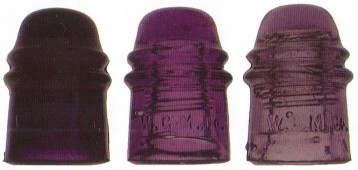
CD 121 Range of Purples: Black purple,
medium dark purple, light purple.
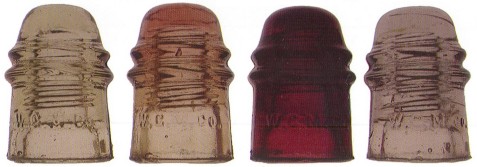
CD 121 Unusual Colors: Greenish straw,
light burgundy/peach two-tone,
burgundy, silver.
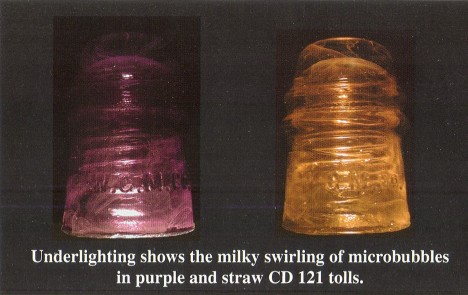
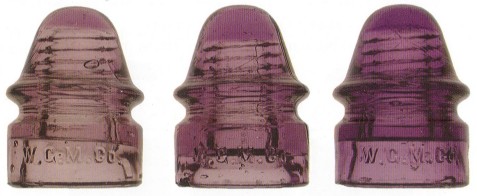
Range of purple coloring in CD 134 signals.
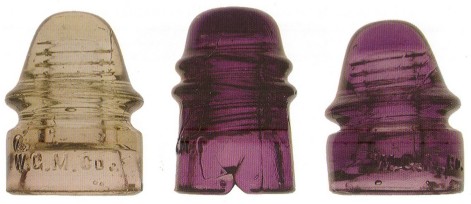
CD 134 in light straw, CD 121 with "hairlip", CD 134
"leaner".
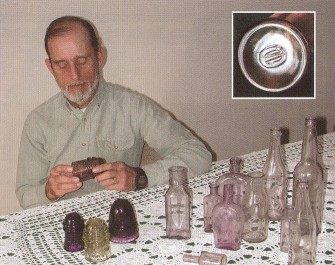
Western Glass Manufacturing specialist,
Tom Katonak, with WGM bottles and
insulators.
(Insert Photo)
"Belt -buckle" logo on a WGM whisky miniature.
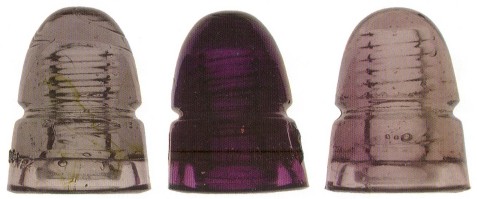
Unusual CD 145s: Silver with amber swirls, dark purple with
cooling lehr
"kiss" on the right skirt, two-tone purple/straw.
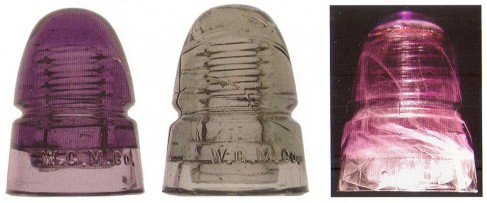
CD 145 medium purple narrow-dome style, rare greenish-gray and
an underlit
purple with milky swirling of microbubbles.
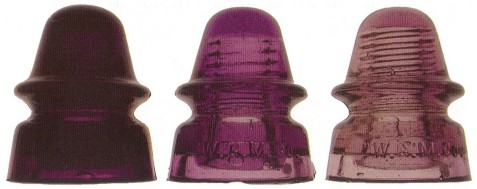
CD 162 Range of purples: Dark, medium and light purple.
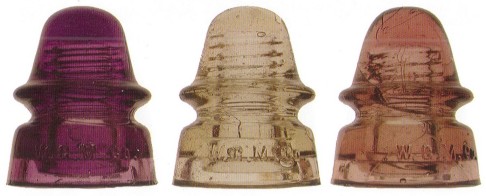
Purple, straw and peach CD 162 signals.
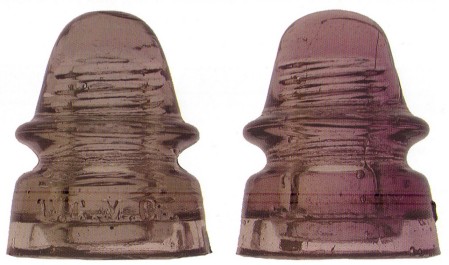
Gray and two-tone examples of CD 162 signals.
When I first started specializing in WGM insulators, it took me nearly two
years to obtain a 134, and it was pretty badly damaged. The color range on these
tends more to the medium purple shade with light purple and deep purple being
more unusual. In a separate picture, I show the very rare light straw 134. I
have heard collectors talk about this unusual color for many years, but this is
the only specimen of this sort that I have ever personally seen.
The CD 145
comes next in the numerical lineup. The 145 shape was commonly used as the
railway telegraph insulator throughout the Rocky Mountain west. There are two
"sub-styles" of this shape: The classic chunky variant, and a
"slimmed down" version close to the shape of a postal style beehive
(see accompanying photo). By far, the chunky style is more common. Again, we
find royal purple to be a common color for this shape, but all shades of purple
are to be found including black purple on one end of the spectrum and light
lilac on the other. Very occasionally, the WGM beehives are found in silver or
straw, again the result of being used inside buildings or having had a coat of
paint applied so they were not subjected to the color-altering UV radiation.
While amber streaking is most unusual in WGM insulators, on the rare occasion
that you do find it in the WGM glass, the odds are that it will occur in a CD
145.
Finally, we come to the highest numbered WGM CD, the 162. The CD 162 was
used for signaling purposes on the Denver and Rio Grande Railroad, and also for
light power applications in many of the western towns. As it turns out, the
bases of the WGM CD 162s are relatively fragile; a large fraction of specimens
have considerable base damage. In fact, to find a WGM signal in so-called
"mint" condition is most unusual!
Again, most of the CD 162s are to be
found in various shades of purple. Probably the most common shade is close to
medium purple, but royal purple shades are available as are the very pale purple
shades. Interestingly, two-tone effects are perhaps most pronounced in this CD.
Beautiful combinations of straw and light rosy purple exist and are in high
demand. Light non-purple specimens occur occasionally like in the other WGM CDs,
although I have yet to find a pale green example. The accompanying photographs
show the range of purpling, straw and peach examples, and the gray and two-tone
specimens.
No discussion of the WGM glass insulators would be complete without
mentioning "misfits". By "misfits", I'm referring to
insulators that are misshapen, or contain bubbles, swirls of other colored
glass, or steam. Compared to the glass of the Western Flint Glass Company
production, which was known for its crudity, bubbles, swirls, gunk, etc., the
WGM operation produced pristine glass. You find very few bubbly pieces,
especially pieces with large bubbles, and only rarely pieces with steam or steamy swirls. I've included here some pictures of a pair of tolls full
of steam, and also a steam-swirled beehive. Such pieces are most uncommon in
tolls, and rare in other CDs. Apparently, the WGM plant had very good quality
control so the examples shown here of the toll with the under-pour and the CD
134 that leans are essentially "freak occurrences". It is also very
unusual to find dramatic amber swirls in the WGM glass. Occasionally one might
find a "spot" of amber, or a thin amber wisp, but almost never a
well-swirled piece. Deformation as a result of colliding or touching in the
cooling lehr also falls in with the "misfits". What happens in this
case is that an insulator in the lehr bumps up against another piece, and the
two stick together because the cooling glass is still soft and sticky. When the
workman separates the insulators, a small chunk of glass is pulled off one of
the pieces. Again, you don't see this very often because the workmen were quite
careful to keep the hot insulators well separated as they placed them on the
cooling table. You can see a photo example of the "lehr kiss" on the
right side of the skirt on a CD 145 in this article.
While quality control was
relatively good for an insulator manufacturer, certain aspects of quality
diminished as WGM ran into the lean years. I haven't done enough research to
determine how many different molds were used for each of the styles, but from
studying the glass, it is clear that the molds were used well beyond their
useful life. Late production insulators, particularly the tolls, show obvious
signs of mold damage due to heat. In several cases, the mold wear has been
repaired and you can see the imprint of the repair on the insulator itself.
Symptoms of spent molds include extrusion spurs along the mold lines and
"mushy" embossings.
The Bottles:
The Western Glass Manufacturing Company's major product was
glass bottles, and they supplied a vast number of bottles to the area's
commercial industries. Bottles of every shape and description were made during
the first decade of the 1900s. Many of the large food processors of the west
depended on WGM to supply them with bottles for the canning of foodstuffs. WGM
probably made more soda and beer bottles than anything else, but patent medicine
bottles and various food containers, for example pickle bottles, were in wide
distribution. The Kuner Company, a large Denver food processing and distribution
outfit, bought thousands of clear glass bottles to package their wares in. Many
of these bottles were embossed "KUNER" in large stick letters. A few
of the beer bottles were made of amber glass, much the same color as modern beer
bottles, but on the whole, WGM bottles were made of Manganese dioxide-laced
clear glass. These clear bottles eventually turned various shades of purple of
course, just like the insulators, but there are many more instances of finding non-purple glass as compared to finding clear insulators. One assumes
most bottles, once used, ended in landfills where they were not irradiated by
the sun. Many bottle dealers and collectors take the clear glass bottles and
place them in "purpling boxes" for a month or so to bring out the
purple colors. Strangely enough, there are no known examples of WGM insulators
occurring in light aqua, blue aqua and amber although these colors do occur in
the WGM bottles. This may indicate that there were actually two entirely
different process operations at the plant and that even the glass tanks were
separate. The trademark oval with a horizontal bar across the long axis
(nicknamed "the belt buckle") was usually embossed on the bottom of
each bottle to represent the logo depicted in this article. In rare cases, the
embossing "W.G.M. Co." is actually embossed on the bases.
Conclusions:
So here we have the story about one of America's most prolific
producers of glass insulators and bottles in the early part of the 20th Century!
In essence, the economy of the Rocky Mountain States rested on the output of a
small glass company in Valverde Colorado. Insulator collectors from around the
world treasure the beautiful purple glass with the W.G.M. Co. embossing.
Acknowledgments:
I would like to thank Denver glass authority Mike Miller for
his extensive consultation and advice. I am also indebted to Carol McDougald for
making all the photographs in this article look like real WGM insulators!
|
